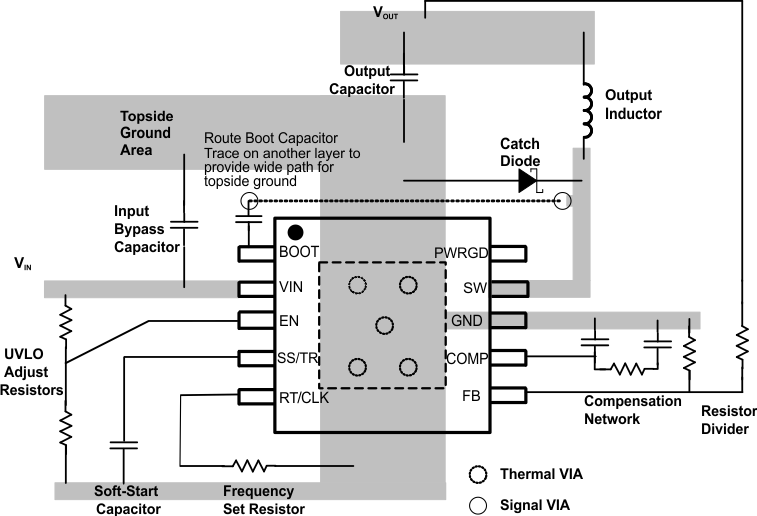SLVSC57C October 2013 – January 2017 TPS54541
PRODUCTION DATA.
- 1 Features
- 2 Applications
- 3 Description
- 4 Revision History
- 5 Pin Configuration and Functions
- 6 Specifications
-
7 Detailed Description
- 7.1 Overview
- 7.2 Functional Block Diagram
- 7.3
Feature Description
- 7.3.1 Fixed-Frequency PWM Control
- 7.3.2 Slope Compensation Output Current
- 7.3.3 Pulse Skip Eco-mode
- 7.3.4 Low Dropout Operation and Bootstrap Voltage (BOOT)
- 7.3.5 Error Amplifier
- 7.3.6 Adjusting the Output Voltage
- 7.3.7 Enable and Adjusting Undervoltage Lockout
- 7.3.8 Soft-Start/Tracking Pin (SS/TR)
- 7.3.9 Sequencing
- 7.3.10 Constant Switching Frequency and Timing Resistor (RT/CLK) Pin)
- 7.3.11 Synchronization to RT/CLK Pin
- 7.3.12 Maximum Switching Frequency
- 7.3.13 Accurate Current Limit Operation
- 7.3.14 Power Good (PWRGD Pin)
- 7.3.15 Overvoltage Protection
- 7.3.16 Thermal Shutdown
- 7.3.17 Small-Signal Model for Loop Response
- 7.3.18 Simple Small-Signal Model for Peak-Current-Mode Control
- 7.3.19 Small Signal Model for Frequency Compensation
- 7.4 Device Functional Modes
-
8 Application and Implementation
- 8.1 Application Information
- 8.2
Typical Applications
- 8.2.1
Buck Converter for 6-V to 42-V Input and 3.3-V at 5-A Output
- 8.2.1.1 Design Requirements
- 8.2.1.2
Detailed Design Procedure
- 8.2.1.2.1 Custom Design with WEBENCH® Tools
- 8.2.1.2.2 Selecting the Switching Frequency
- 8.2.1.2.3 Output Inductor Selection (LO)
- 8.2.1.2.4 Output Capacitor
- 8.2.1.2.5 Catch Diode
- 8.2.1.2.6 Input Capacitor
- 8.2.1.2.7 Slow-Start Capacitor
- 8.2.1.2.8 Bootstrap Capacitor Selection
- 8.2.1.2.9 Undervoltage Lockout Set Point
- 8.2.1.2.10 Output Voltage and Feedback Resistors Selection
- 8.2.1.2.11 Compensation
- 8.2.1.2.12 Power Dissipation Estimate
- 8.2.1.2.13 Safe Operating Area
- 8.2.1.2.14 Discontinuous Conduction Mode and Eco-mode Boundary
- 8.2.1.3 Application Curves
- 8.2.2 Inverting Buck-Boost Topology for Positive Input to Negative Output
- 8.2.3 Split-Rail Topology for Positive Input to Negative and Positive Output
- 8.2.1
Buck Converter for 6-V to 42-V Input and 3.3-V at 5-A Output
- 9 Power Supply Recommendations
- 10Layout
- 11Device and Documentation Support
- 12Mechanical, Packaging, and Orderable Information
Package Options
Mechanical Data (Package|Pins)
- DPR|10
Thermal pad, mechanical data (Package|Pins)
- DPR|10
Orderable Information
10 Layout
10.1 Layout Guidelines
Layout is a critical portion of good power supply design. There are several signal paths that conduct fast-changing currents or voltages that interact with stray inductance or parasitic capacitance to generate noise or degrade performance. To reduce parasitic effects, bypass the VIN pin to ground with a low-ESR ceramic bypass-capacitor with X5R or X7R dielectric. Minimize the loop area formed by the bypass-capacitor connections, the VIN pin, and the anode of the catch diode. See Figure 73 for a PCB layout example. Tie the GND pin directly to the thermal pad under the IC.
Connect the thermal pad to internal PCB ground planes using multiple vias directly under the IC. Route the SW pin to the cathode of the catch diode and to the output inductor. Because the SW connection is the switching node, locate the catch diode and output inductor close to the SW pins, and the area of the PCB conductor minimized to prevent excessive capacitive coupling. For operation at full rated load, ensure the top-side ground area provides adequate heat dissipating area. The RT/CLK pin is sensitive to noise so locate and rout the RT resistor as close as possible to the IC with minimal lengths of trace, respectively. The additional external components are placed approximately as shown. Obtaining acceptable performance with alternate PCB layouts is possible, however this layout produces good results and TI intends it as a guideline.
10.2 Layout Example
 Figure 73. PCB Layout Example
Figure 73. PCB Layout Example
10.3 Estimated Circuit Area
Boxing in the components in the design of Figure 46 the estimated printed circuit board area is 1.025 in2 (661 mm2). This area does not include test points or connectors.